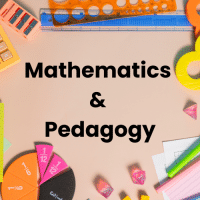CTET & State TET Exam > CTET & State TET Questions > To make learning interesting and easier for c...
Start Learning for Free
To make learning interesting and easier for children with learning disabilities, teachers can use mnemonics to remember complex order of things. For which type of learning disability can this mnemonic strategy be applied?
- a)Dyscalculia
- b)Dysgraphia
- c)Dyslexia
- d)Dyspraxia
Correct answer is option 'A'. Can you explain this answer?
| FREE This question is part of | Download PDF Attempt this Test |
Most Upvoted Answer
To make learning interesting and easier for children with learning dis...
Learning disability refers to a neurological disorder that causes cognitive impairment. Dyslexia, dysgraphia, dyscalculia, etc. are the most common learning disability.
Attention CTET & State TET Students!
To make sure you are not studying endlessly, EduRev has designed CTET & State TET study material, with Structured Courses, Videos, & Test Series. Plus get personalized analysis, doubt solving and improvement plans to achieve a great score in CTET & State TET.

|
Explore Courses for CTET & State TET exam
|

|
Similar CTET & State TET Doubts
To make learning interesting and easier for children with learning disabilities, teachers can use mnemonics to remember complex order of things. For which type of learning disability can this mnemonic strategy be applied?a)Dyscalculiab)Dysgraphiac)Dyslexiad)DyspraxiaCorrect answer is option 'A'. Can you explain this answer?
Question Description
To make learning interesting and easier for children with learning disabilities, teachers can use mnemonics to remember complex order of things. For which type of learning disability can this mnemonic strategy be applied?a)Dyscalculiab)Dysgraphiac)Dyslexiad)DyspraxiaCorrect answer is option 'A'. Can you explain this answer? for CTET & State TET 2024 is part of CTET & State TET preparation. The Question and answers have been prepared according to the CTET & State TET exam syllabus. Information about To make learning interesting and easier for children with learning disabilities, teachers can use mnemonics to remember complex order of things. For which type of learning disability can this mnemonic strategy be applied?a)Dyscalculiab)Dysgraphiac)Dyslexiad)DyspraxiaCorrect answer is option 'A'. Can you explain this answer? covers all topics & solutions for CTET & State TET 2024 Exam. Find important definitions, questions, meanings, examples, exercises and tests below for To make learning interesting and easier for children with learning disabilities, teachers can use mnemonics to remember complex order of things. For which type of learning disability can this mnemonic strategy be applied?a)Dyscalculiab)Dysgraphiac)Dyslexiad)DyspraxiaCorrect answer is option 'A'. Can you explain this answer?.
To make learning interesting and easier for children with learning disabilities, teachers can use mnemonics to remember complex order of things. For which type of learning disability can this mnemonic strategy be applied?a)Dyscalculiab)Dysgraphiac)Dyslexiad)DyspraxiaCorrect answer is option 'A'. Can you explain this answer? for CTET & State TET 2024 is part of CTET & State TET preparation. The Question and answers have been prepared according to the CTET & State TET exam syllabus. Information about To make learning interesting and easier for children with learning disabilities, teachers can use mnemonics to remember complex order of things. For which type of learning disability can this mnemonic strategy be applied?a)Dyscalculiab)Dysgraphiac)Dyslexiad)DyspraxiaCorrect answer is option 'A'. Can you explain this answer? covers all topics & solutions for CTET & State TET 2024 Exam. Find important definitions, questions, meanings, examples, exercises and tests below for To make learning interesting and easier for children with learning disabilities, teachers can use mnemonics to remember complex order of things. For which type of learning disability can this mnemonic strategy be applied?a)Dyscalculiab)Dysgraphiac)Dyslexiad)DyspraxiaCorrect answer is option 'A'. Can you explain this answer?.
Solutions for To make learning interesting and easier for children with learning disabilities, teachers can use mnemonics to remember complex order of things. For which type of learning disability can this mnemonic strategy be applied?a)Dyscalculiab)Dysgraphiac)Dyslexiad)DyspraxiaCorrect answer is option 'A'. Can you explain this answer? in English & in Hindi are available as part of our courses for CTET & State TET.
Download more important topics, notes, lectures and mock test series for CTET & State TET Exam by signing up for free.
Here you can find the meaning of To make learning interesting and easier for children with learning disabilities, teachers can use mnemonics to remember complex order of things. For which type of learning disability can this mnemonic strategy be applied?a)Dyscalculiab)Dysgraphiac)Dyslexiad)DyspraxiaCorrect answer is option 'A'. Can you explain this answer? defined & explained in the simplest way possible. Besides giving the explanation of
To make learning interesting and easier for children with learning disabilities, teachers can use mnemonics to remember complex order of things. For which type of learning disability can this mnemonic strategy be applied?a)Dyscalculiab)Dysgraphiac)Dyslexiad)DyspraxiaCorrect answer is option 'A'. Can you explain this answer?, a detailed solution for To make learning interesting and easier for children with learning disabilities, teachers can use mnemonics to remember complex order of things. For which type of learning disability can this mnemonic strategy be applied?a)Dyscalculiab)Dysgraphiac)Dyslexiad)DyspraxiaCorrect answer is option 'A'. Can you explain this answer? has been provided alongside types of To make learning interesting and easier for children with learning disabilities, teachers can use mnemonics to remember complex order of things. For which type of learning disability can this mnemonic strategy be applied?a)Dyscalculiab)Dysgraphiac)Dyslexiad)DyspraxiaCorrect answer is option 'A'. Can you explain this answer? theory, EduRev gives you an
ample number of questions to practice To make learning interesting and easier for children with learning disabilities, teachers can use mnemonics to remember complex order of things. For which type of learning disability can this mnemonic strategy be applied?a)Dyscalculiab)Dysgraphiac)Dyslexiad)DyspraxiaCorrect answer is option 'A'. Can you explain this answer? tests, examples and also practice CTET & State TET tests.

|
Explore Courses for CTET & State TET exam
|

|
Suggested Free Tests
Signup for Free!
Signup to see your scores go up within 7 days! Learn & Practice with 1000+ FREE Notes, Videos & Tests.
























